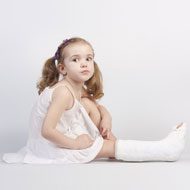- Baby care
- Baby Crying
- Baby Feeding
- Baby Growth
- Baby Language
- Baby Name
- Baby Potty Training
- Baby Safety
- Baby Shower
- Baby Sleep
- Baby Teething
- Bathing a Baby
- Early Pregnancy Signs
- Late Pregnancy
- Miscarriage
- Molar Pregnancy
- Post Pregnancy
- Postpartum Depression
- Pre Pregnancy
- pregnancy care
- Pregnancy Conditions
- Pregnancy Diet
- Pregnancy Due Date
- Pregnancy Exercise
- Pregnancy Heartburn
- Pregnancy Sex
- Pregnancy Sleep
- Pregnancy Stages
- Pregnancy Stretch Marks
- Pregnancy Style and Fashion
- Preschooler
- Second Pregnancy
- Teen Pregnancy
- Toddler Activities
- Toddler Behavior
- Toddler Discipline
- Toddler Food
- Toddler Illness and Injuries
- Toddler Speech
- Twin Pregnancy
Toddler Fracture Treatment

Toddlers love to run, climb, and jump, and when they do these, they often fall and get hurt. Many a times, they escape with a minor bruise, and at times, it is a muscle pull. However, sometimes, it can be a ligament injury and or a bone fracture.
A fracture happens when the bone cracks but does not break. There are many types of Toddler fractures, and each fracture has to be treated differently. Fractures are very common in children. Unlike adults, children are more prone to fractures than sprains. The reason behind this is that children, especially toddlers, have fibrous ligaments that are stronger than the growing parts of their bones.
A broken finger is often caused because of a blow to the finger. A fracture in the upper arm is the result of falling backwards and breaking the fall with the elbow. Similarly a broken wrist or lower arm is a result of falling forward and breaking the fall with an outstretched hand. This is the most common form of fractures in toddlers.
Fractures in the legs are the result of falling during play. Ankle fractures are again very common among toddlers. They may often be mistaken as a minor sprain. Since the growing parts of the bones are weaker than the fibrous ligaments, this type of simple fall can cause a fracture in children, albeit it may lead to only a sprain in adults.
How to Identify a Toddler Fracture
You can tell whether that your toddler has suffered a fracture by observing the following signs:
- Swelling
- Pain
- Bruising
- Difficulty in moving the affected limb
Please note that the healing time depends on the location and severity of the fracture. The doctor can determine the severity of the fracture by taking an X-ray.
Treating fractures in toddlers
Children’s bones heal quickly and in a much better way as compared to those of adults. Most types of fractures heal on their own by using techniques like immobilization in a cast or splint. On the other hand, fractures in toes or fingers may heal with the help of buddy taping, wherein the broken digit next to it is taped for stabilization.
On rare occasions, fractures may need realignment, wherein the bones may be required to be realigned. In such cases, surgery may be required to realign the bones or to stabilize them. This is very rare condition in children and is more frequent in adults.
You can prevent fractures by providing your children with safety equipment and by having good adult supervision as the young tots play. If your child loves climbing windows, ensure that they are sturdy and will not fall apart the moment your child climbs onto them. By following such simple tips, you can avoid fractures, and your toddler can enjoy playtime properly and to the fullest.
- RSS Feeds -
- All posts
- All comments
- Toddler Clavicle Fracture Toddler clavicle fracture, though not very common, can be an extremely painf
- Toddler Fractured Foot It might appear surprising, but it is a fact that toddler fractures are not
- Fever and Your Child If your normally playful and happy toddler has not been his or her usual sel
- Toddler Diarrhea Treatment Any illness in a toddler can make the parents anxious. When your toddler get